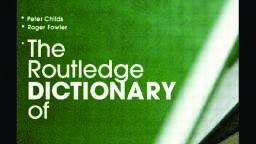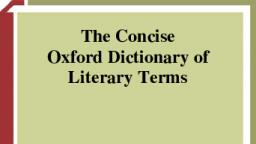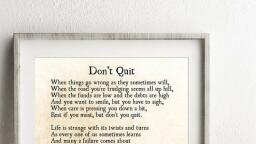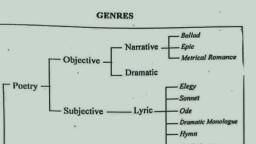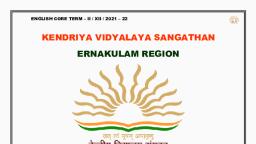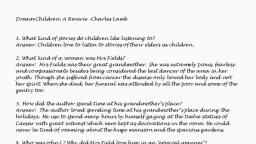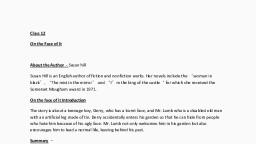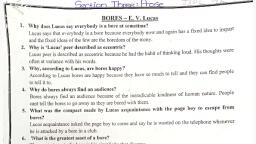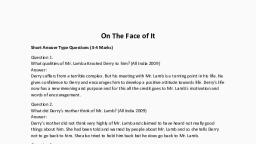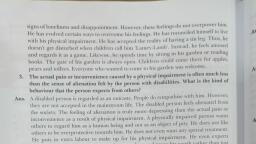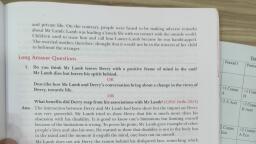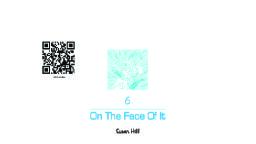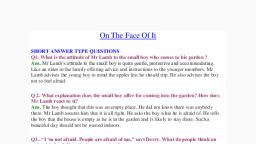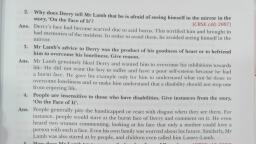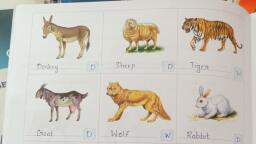Page 1 :
(Some of the excerpts have been borrowed from the e-content of Lovely Professional University, keeping in view the pandemic condition in which the students need materials which they can, prepare within a very short span of time in this session only. It shall neither be used in future nor, any professional purposes.), , DREAM CHILDREN: A REVERIE, CHARLES LAMB, , Summary, The children of James Elia, John and Alice, asked him to tell them about his grand -mother and, their great grandmother- Mrs. Field who used to live in a great mansion in Norfolk. The house, belonged to a rich nobleman who lived in another new house. Grandmother Field was the keeper, of the house and she looked after the house with great care as though it was her own. The tragic, incident of the two children and their cruel uncle had taken place in the house. The children had, come to know the story from the ballad of ‘The Children in the wood’. The story was carved in, wood upon the chimney piece. But a foolish rich person later pulled down the wooden chimney, and put a chimney of marble. The new chimney piece had no story on it. Alice was very unhappy, that the rich man had pulled down the chimney piece with the story. She looked upbraiding and, her anger was like her mother’s., When the house came to decay later, after the death of Mrs. Field the nobleman carried away the, ornaments of the house and used them in his new house. The ornaments of the old house looked, very awkward in the new house, just like the beautiful tombs of Westminster Abbey would look, awkward if placed in someone’s drawing room. Things looked beautiful only if they are in, harmony with the surroundings. John enjoyed the comparison and smiled as if he also felt it, would be very awkward indeed. Grandmother Field was a very good lady. She was also very, religious for she was well acquainted with ‘The Book of Psalms’ in ‘The Old Testament’ and a, great portion of ‘The New Testament’ of ‘The Bible’. Alice here spread her hands as if she was, not interested in the praise of a quality of the grandmother that she herself did not have. Children, find it difficult to learn lessons by heart.
Page 2 :
Grandmother Field did not fear the spirits of the two infants which haunted the house at night. So, she slept alone. But Elia used to sleep with his maid as he was not so religious. John tried to look, courageous but his eyes expanded in fear. When the grandmother died many people in the, neighbourhood including the gentry or the aristocrats attended her funeral. She was also a good, dancer when she was young. Here, Alice moved her feet unconsciously as she too was interested, in dancing. Grandmother Field was tall and upright but later she was bowed down by a disease, called cancer. She was good to her grand children. Elia in childhood used to spend his holiday, there. He used to gaze upon the bust of the twelve Caesars or roam about in the mansion or in the, garden. In the garden, there were fruits like nectarines, peaches, oranges and others. Elia never, plucked them but rather enjoyed looking at them. Here John deposited a bunch of grapes upon, the plate again. He was showing that he too was not tempted by fruits., • His farce, Mr H, was performed at Drury Lane in 1807., • Fortuitously, Lamb’s first publication was in 1796., • His collected essays, under the title Essays of Elia, were published in 1823., , Critical Analysis, This essay is about a dream. In this essay all characters are real except the children Alice and, John. From the title we can guess that it’s a dream and reverie, i.e., a day dream. Alice and John, are children of James Elia (Charles Lamb). They ask their father, James Elia, to tell them about, their grandmother. Grandmother’s name is Field who has been acquainted to us by Lamb as a, perfect woman with great qualities. Incidents are real from the life of Lamb. There is a story, related to the house where grandmotherMrs Field was a keeper. It was about the murder of, children by their cruel uncle. Alice and John came to know this story through a carved writing on, a tree which was later brought down by a rich man. After the death of grandmother, house owner, took away her belongings and placed them in his new house where they looked awkward. When, grandmother was alive she used to sleep alone but Elia was afraid of the souls of infants, murdered by uncle as it was thought that house was haunted by the spirits of those children. Elia, had a brother John full of enthusiasm and zeal, who was loved by everyone specially by their, grandmother on the other hand Elia’s childhood was full of isolation and he remained stagnant
Page 3 :
throughout his life. His mind was working fast but bodily or physically he was totally off and, lazy. He was lame and helped by John in every possible way who used to carry him in his back., Unfortunately, John also became lame but Elia never helped him and after his death he realized, missing him. At the end of the essay, Alice and John are crying after hearing all this. Elia is, looking his wife, whose name also Alia, in Alices face. The childern start to become faint and, say to Elia or Lamb that we are not your real children and Alice is not your wife and our mother., Lamb wakes up and finds himself in armed chair and James Elia was vanished. The whole story, is based on life of Lamb, he was never able to get married and childless died. He is also, regretting and remembering moments like, about his brother, about grandmother, his childhood, etc. So, whole of essay is full of melancholy and sad tone of Lamb’s life. (One should better, study about Lamb’s short biography in order to understand his essays). A Stylistic Analysis on, Lamb’s Dream Children Charles Lamb was a famous English prose-writer and the best, representative of the new form of English literature early in the nineteenth century. He did not, adhere to the old rules and classic models but made the informal essay a pliable vehicle for, expressing the writer’s own personality, thus bringing into English literature the personal or, familiar essay. The style of Lamb is gentle, old-fashioned and irresistibly attractive, for which I, can think of no better illustration than Dream Children: A Reverie. From the stylistic analysis of, this essay we can find Lamb’s characteristic way of expression. Dream Children records the, pathetic joys in the author’s unfortunate domestic life. We can see in this essay, primarily, a, supreme expression of the increasing loneliness of his life. He constructed all that preliminary, tableau of paternal pleasure in order to bring home to us in the most poignant way his feeling of, the solitude of his existence, his sense of all that he had missed and lost in the world. The key to, the essay is one of profound sadness. But he makes his sadness beautiful; or, rather, he shows the, beauty that resides in sadness. There are remarkable writing techniques to achieve such an effect., , On Humour and Pathos as Used by Charles Lamb, “Some things are of that nature as to make One’s fancy chuckle while his heart doth ache”, Wrote Bunyan. The nature of things mostly appeared to Charles Lamb in this way. Lamb does, not frolic out of lightness of heart, but to escape from gloom that might otherwise crush. He, laughed to save himself from weeping. In fact, Lamb’s personal life was of disappointments and, frustrations. But instead of complaining, he looked at the tragedies of life, its miseries and
Page 4 :
worries as a humorist. Thus his essays become an admixture of humour and pathos. Examples of, his keen sense of humour and pathetic touches are scattered in all of his essays. Let’s focus our, discussion on Dream Children: A Reverie. Notes LOVELY PROFESSIONAL UNIVERSITY 41, Unit 4: Charles Lamb-Dream Children : A Reverie-A Critical Analysis In Lamb’s writing wit,, humour and fun are interwoven and it is humour which is most notable for its extreme, sensitiveness to the true proportion of things. Lamb often brings out the two sides of a fact and, causes laughter at our own previous misconceptions. Therefore it borders on the painful, realization. Thus his humour is very nearly allied to pathos. They are different facts of the same, gem. In his essay Dream Children: A Reverie Lamb talks of personal sorrows and joys. He gives, expressions to his unfulfilled longings and desires. He readily enters into the world of fantasy, and pops up stories in front of his dream children. He relates his childhood days, of Mrs. Field,, his grandmother and John Lamb, his brother. He describes how much fun he had at the great, house and orchard in Norfolk. Of his relations he gives us full and living pictures – his brother, John is James Elia of My Relations, but here is John L-, so handsome and spirited youth, and a, ‘king’. John was brave, handsome and won admiration from everybody. Charles’ grandmother, Mrs. Field is the other living picture. She was a good natured and religious– minded lady of, respectable personality. Narrator’s sweet heart Alice Winterton is the other shadowed reality., The Dream Children, Alice and John are mere bubbles of fancy. Thus Lamb’s nostalgic memory, transports us back to those good old days of great grandmother Field. But even in those romantic, nostalgia the hard realities of life does not miss our eyes. Death, separation and suffering inject, us deep-rooted pathos in our heart. Whereas Mrs. Field died of cancer, John Lamb died in early, age. Ann Simmons has been a tale of unrequited love story of Charles Lamb. Notably the, children are millions of ages distant of oblivion and Charles is not a married man but a bachelor, having a reverie. In his actual life Lamb courted Ann Simmons but could not marry her, he, wanted to have children but could not have any. Thus he strikes a very pathetic note towards the, end of his essay when he puts the following word into the months of his imaginary children, “we, are not of Alice, nor of thee, nor are we children at all … We are nothing, less than nothing,, dreams. We are only what might have been”. Alice is here no other girl but Ann Simmons, the, girl Lamb wanted to marry, but failed to marry her. In fact, the subtitle of the essay – ‘A Reverie’, which literally means a daydream or a fantasy – prepares us for the pathos of the return to reality, although the essay begins on a deceptively realistic note. Although Dream Children begins on a
Page 5 :
merry note, the dark side of life soon forces itself upon Lamb’s attention and the comic attitude, gives way to melancholy at the end of the essay. Throughout the essay Lamb presents his, children in such a way that we never guess that they are merely figments of his imagination –, their movements, their reactions, their expressions are all realistic. It is only at the end of the, essay that we realize that the entire episode with his children is a daydream. We are awakening, by a painful realization of the facts. Lamb’s humour was no surface play, but the flower plucked, from the nettle of peril and awe. In fact, Lamb’s humour and pathos take different shapes in, different essays. Sometimes it is due to his own unfulfilled desires, sometimes it is due to the illfortunes of his relatives and friends and on some other occasions it is due to his frustration in, love etc. If his Poor Relations begin humorously of a male and female poor relation, he later, gives us a few pathetic examples of poor relations that had to suffer on account of poverty. Again, in his The Praise of Chimney Sweepers Lamb sways between humour and pathos while, describing the chimney sweepers. Similarly the essay Dream Children is a beautiful projection of, Lamb’s feelings and desire to have a wife and children of his own. It is humorous that in his, dream he is married and has two children of his own while he had a disheartening frustration in, love. Thus Lamb has painted both the lights and shades of life in full circle. His is the criticism, of life in pathos and humours. Features Narration Enlivened by Depiction of the Children As is, illustrated in sentences (5) and (6), the author’s narration of the great-grandmother and his, brother is enlivened by a certain depiction concerning the children. Incidentally, while preparing, his ultimate solemn effect, Lamb has inspired us with a new, intensified vision of the wistful, beauty of children—their imitativeness, their facile and generous emotions, their anxiety to be, correct, their ingenuous haste to escape from grief into joy. This vision gives us an impression, that they seem real, thus makes the revelation in the end touching and pathetic. Unexpected, Ending Dream Children begins quite simply, in a calm, narrative manner, representing Lamb as, sitting by his fireside on a winter night telling stories to his own dear children, and delighting in, their society, until he suddenly comes to his old, solitary, bachelor self, and finds that they were, but dream-children. In the end of the essay, we read: That I became in doubt which of them stood, there before me, or whose that bright hair was; and while I stood gazing, both the children, gradually grew fainter to my view, receding, and still receding till nothing at last but two, mournful features were seen in the uttermost distance, which, without speech, strangely, impressed upon me the effects of speech; “We are not of Alice, nor of thee, nor are we children
Page 6 :
at all. The children of Alice called Bartrum father. We are nothing, less than nothing, and, dreams. We are only what might have been, and must wait upon the tedious shores of Lethe, millions of ages before we have existence, and a name.” Reflecting upon the essay, we will, surely be obsessed by the beauty of old houses and gardens and aged virtuous characters, the, beauty of children, the beauty of companionships, the softening beauty of dreams in an armchair—all these are brought together and mingled with the grief and regret which were the origin, of the mood. Rhetorical Devices Lamb introduces some rhetorical devices to make his essay, vivid and profound, such as: And how the nectarines and peaches hung upon the walls, without, my ever offering to pluck them, because they were forbidden fruit, unless now and then, (metaphor) Till I could almost fancy myself ripening too along with the oranges and the limes in, that grateful warmth (empathy) The nature of things mostly appeared to Charles Lamb in this, way. Lamb did not frolic out of lightness of heart, but to escape from gloom that might otherwise, crush. He laughed to save himself from weeping. In fact, Lamb’s personal life was of, disappointments and frustrations. But instead of complaining, he looked at the tragedies of life,, its miseries and worries as a humorist. Thus his essays become an admixture of humour and, pathos. Examples of his keen sense of humour and pathetic touches are scattered in all of his, essays. Let’s focus our discussion on Dream Children: A Reverie. Characters The young couple, in the ancient Dutch farming village (in New England) who are the major living characters in, “Dream Children” are the McNairs. The outward placidity that the pleasant and personable Mrs., McNair displays in her daily goings about among the villagers gives the impression that nothing, bad or disturbing has taken place in her life. Yet the reckless manner in which she rides her, stallion through the fields causes wonderment among some of the locals, such as Mrs. DePuy, and her husband, who own the old Patroon farm near the McNairs’ land. Dream Children:, Themes Expressed as a directive, a major theme of this story is “Measure a person by his or her, sense of loss.” The young wife whose infant was stillborn is utterly transformed by the tragedy,, going off on a new life course which is largely regulated by her ongoing need to penetrate by, whatever means the unbreachable time-space wall of human existence and, in defiance of all, logic, reason, and conventional wisdom, to be reunited with her lost baby son. Her husband,, clearly not needing replacement therapy comparable with hers, reconstructs his life in the most, convenient and thoughtful fashion... Godwin’s “Dream Children” examines themes of marriage,, self-definition, and loss. 1. Taking into account its subject matter and Godwin’s handling of the
Page 7 :
narrative structure, were you particularly affected emotionally by “Dream Children”? If so,, explain. 2. Was the ending of the story, with its rhetorical question about Mrs. McNair’s, happiness, effective in “wrapping up” the story of her life? Comment either way, or both ways., 3. What in your opinion is the purpose of all the italicized passages throughout the story? Who is, saying or thinking those things? How do..., • In Lamb’s writing wit, humour and fun are interwoven and it is humour which is most notable, for its extreme sensitiveness to the true proportion of things. Lamb often brings out the two sides, of a fact and causes laughter at our own previous misconceptions. Therefore it borders on the, painful realization. Thus his humour is very nearly allied to pathos. They are different facts of, the same gem. Lamb talks of personal sorrows and joys. He gives expressions to his unfulfilled, longings and desires. He readily enters into the world of fantasy and pops up stories in front of, his dream children. He relates his childhood days, of Mrs. Field, his grandmother and John, Lamb, his brother. He describes how fun he had at the great house and orchard in Norfolk. Of his, relations he gives us full and living pictures–his brother John is James Elia of My Relations, but, here is John L-, so handsome and spirited youth, and a ‘king’. John was brave, handsome and, won admiration from everybody Charles’ grandmother Mrs. Field is the other living picture. She, was a good natured and religious–minded lady of respectable personality. Narrator’s sweet heart, Alice Winterton is the other shadowed reality. The Dream Children, Alice and John are mere, bubbles of fancy. Thus Lamb’s nostalgic memory transports us back to those good old days of, great grandmother Field. But even in those romantic nostalgia the hard realities of life does not, miss our eyes. Death, separation and suffering inject us deep-rooted pathos in our heart. Whereas, Mrs. Field died of cancer, John Lamb died in early age. Ann Simmons has been a tale of, unrequited love story of Charles Lamb. Notably the children are millions of ages distant of, oblivion and Charles is not a married man but a bachelor having a reverie. • In his actual life, Lamb courted Ann Simmons but could not marry her, he wanted to have children but could not, have any. Thus he strikes a very pathetic note towards the end of his essay when he puts the, following word into the months of his imaginary children, “we are not of Alice, nor of thee, nor, are we children at all … We are nothing, less than nothing, dreams. We are only what might, have been”. Alice is here no other that Ann Simmons the girl Lamb wanted to marry, but failed, to marry her. In fact, the subtitle of the essay–‘A Reverie’ which literally means a daydream or a, fantasy–prepares us for the pathos of the return to reality although the essay begins on a
Page 8 :
deceptively realistic note. • Although Dream Children begins on a merry note, the dark side of, life soon forces itself upon Lamb’s attention and the comic attitude gives way to melancholy at, the end of the essay. Throughout the essay Lamb presents his children in such a way that we, never guess that they are merely figments of his imagination – their movements, their reactions,, their expressions are all realistic. It is only at the end of the essay that we realize that the entire, episode with his children is a daydream. We are awakening by a painful realization of the facts. •, Lamb’s humour was no surface play, but the flower plucked from the nettle of peril and awe. In, fact, Lamb’s humour and pathos take different shapes in different essays. Sometimes it is due to, his own unfulfilled desires, sometimes it is due to the illfortunes of his relatives and friends and, on some other occasions it is due to his frustration in love etc. If his Poor Relations begin, humorously of a male and female poor relation, he later gives us a few pathetic examples of poor, relations that had to suffer on account of poverty. Again in his The Praise of Chimney Sweepers, Lamb sways between humour and pathos while describing the chimney sweepers. Similarly the, essay Dream Children is a beautiful projection of Lamb’s feelings and desire to have a wife and, children of his own. It is humorous that in his dream he is married and has two children of his, own while he had a disheartening frustration in love. Thus Lamb has painted both the lights and, shades of life in full circle. His is the criticism of life in pathos and humours. 1. Charles Lamb, entitled the essay “Dream Children” because he never married and naturally never became the, father of any children. The children he speaks of in the essay were actually the creations of his, imagination or fancy. Lamb had a sister, Mary Lamb, who did not marry since she had attacks of, insanity. She has been referred to here as “faithful Bridget” because she never married and was, Lamb’s only companion in his life. At the sudden breakdown of his reverie, he finds her seated, by his side. 3. Dream Children is a personal essay. Lamb presents the characters and incidents, from his own life—the sketches of his grandmother Mrs. Field, his brother—John Lamb, his, sister—Mary Lamb, his tragic love-affairs with Ann Simmons. But Lamb always plays with, facts and fictions and transforms the real into the literary., • Through the stylistic approach to Dream Children, we can see that Charles Lamb is a, romanticist, seeking a free expression of his own personality and weaving romance into daily, life. Without a trace of vanity of self-assertion, Lamb begins with himself, with some purely, personal mood or experience, and from this he leads the reader to see life and literature as he saw
Page 9 :
it. It is this wonderful combination of personal and universal interests, together with Lamb’s rare, old style, which make the essay remarkable., • The Last Essays of Elia were published in 1823 and 1833, respectively., • Lamb’s discerning and lively correspondence is collected in The Letters of Charles Lamb, (1935), . • Dream Children records the pathetic joys in the author’s unfortunate domestic life.




